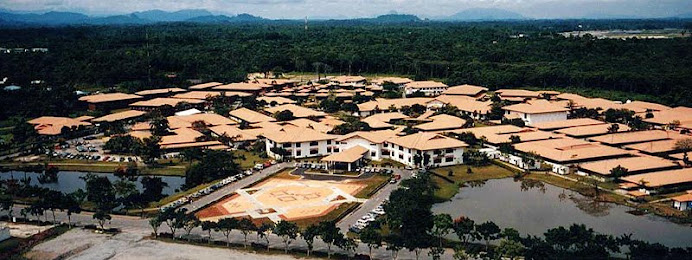As I was selecting a cold drink from a campus food stand, a Malay guy rode up on a motorbike and parked. I asked him if he had any recommendation, then we sat down at a table there to sip and chat, me sampling soursop fruit juice and he drinking iced tea. He has a great big magnetic smile and his name is Muhammad Ghazali. (Those who've taken Whitworth's Core 250 might recognize this name. "Al-Ghazali, all Quran, all the time"…anyone?). He told me that that evening he'd be emceeing a concert where children of UNIMAS staff would be performing traditional Malaysian music, dance, song, and theater, and that I could come if I wanted.
I arrived plenty early at what UNIMAS calls its Experimental Theater, located at the old campus. The set was beautiful and so were the unfamiliar percussion instruments appearing on stage. The only ones I recognized were the gongs, the conga-like drums turned on their sides, and the keyboard instrument which resembled a marimba.
I arrived plenty early at what UNIMAS calls its Experimental Theater, located at the old campus. The set was beautiful and so were the unfamiliar percussion instruments appearing on stage. The only ones I recognized were the gongs, the conga-like drums turned on their sides, and the keyboard instrument which resembled a marimba.
-

 The concert opened up with the Malaysian national anthem which is titled "My Country" and was adopted at independence in 1957. Its lyrics are short and sweet: "My country, the land where my blood is spilt, The people live united and progressive, Blessings of happiness, may God grant, And that our King may reign in peace."
The concert opened up with the Malaysian national anthem which is titled "My Country" and was adopted at independence in 1957. Its lyrics are short and sweet: "My country, the land where my blood is spilt, The people live united and progressive, Blessings of happiness, may God grant, And that our King may reign in peace."First on stage were the musicians. I enjoyed seeing how each instrument was played and what sound it produced. Had I been playing I probably would have chosen the horizontal set of knobbed bronze kettle gongs called the bonang because its parts had variety and it kicked off every song. Considering the redundancy of the rhythms and phrases, the children's ability to end songs together without a cue was baffling. I really don't know how they did it, unless someone up front was giving cues which I never caught.
-

 Next were the dancers who wore exotic costumes and performed graceful and methodical motions to a repetitious percussion jam. Traditional dances from three of Sarawak's major indigenous groups – Iban, Bidayuh, and Melanau – were demonstrated.
Next were the dancers who wore exotic costumes and performed graceful and methodical motions to a repetitious percussion jam. Traditional dances from three of Sarawak's major indigenous groups – Iban, Bidayuh, and Melanau – were demonstrated.
 Next were the actors. They performed a story which I couldn't quite follow, but I knew from their cute costumes that it took place in a forest. During one part they sang and grooved to "You Are My Sunshine," which was just about the only English spoken during the concert.
Next were the actors. They performed a story which I couldn't quite follow, but I knew from their cute costumes that it took place in a forest. During one part they sang and grooved to "You Are My Sunshine," which was just about the only English spoken during the concert. Then a UNIMAS professor made a speech encouraging the children to study hard and to never forget their traditional culture. Finally, all the children came together to perform the finale. It was quite spectacular to see everyone singing and dancing on stage together.
Then a UNIMAS professor made a speech encouraging the children to study hard and to never forget their traditional culture. Finally, all the children came together to perform the finale. It was quite spectacular to see everyone singing and dancing on stage together.  My favorite three children were the adorable boy whose face peeked out from behind his drum, the pretty girl in the white dress who was the star of the play, and the little one kneeling next to her whose facial expression never once changed from how it appears below.
My favorite three children were the adorable boy whose face peeked out from behind his drum, the pretty girl in the white dress who was the star of the play, and the little one kneeling next to her whose facial expression never once changed from how it appears below. -

 After the performance Muhammad invited me along for celebratory tea and food. It was all delicious, especially the tea which was dark, milky, and very sweet. After learning more from Muhammad, who happens to be a senior in my same Faculty of Social Sciences, and meeting some of his friends, it was getting late and I said goodbye. I began walking back to my dorm, but it wasn't long before five guys packed into a very small car offered me a ride. Four in the back seat must have been pretty uncomfortable, but it was only a five minute ride back to Alamanda College.
After the performance Muhammad invited me along for celebratory tea and food. It was all delicious, especially the tea which was dark, milky, and very sweet. After learning more from Muhammad, who happens to be a senior in my same Faculty of Social Sciences, and meeting some of his friends, it was getting late and I said goodbye. I began walking back to my dorm, but it wasn't long before five guys packed into a very small car offered me a ride. Four in the back seat must have been pretty uncomfortable, but it was only a five minute ride back to Alamanda College.
